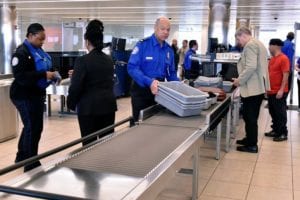Travel mistakes can lead to disastrous journeys. Learn about the worst ones and how to avoid them.

Here are the second set of ten of the 20 worst mistakes travelers should avoid.
Being a TSA PreCheck or Global Entry member can make your journey much easier.

If you’re unaware, Global Entry members automatically get TSA PreCheck benefits. Therefore, if you travel or plan to travel internationally, I suggest Global Entry membership for those eligible. It only costs $22 more than TSA PreCheck to join for the initial five-year membership. That way, when you fly, you get both Global Entry and its benefits for expedited entry into the U.S. and TSA PreCheck benefits.
In recent months when flying, I’ve seen extremely long non-PreCheck lines. In Atlanta, the wait in the regular TSA line was more than an hour, but the Pre-Check was only 10 minutes, and I got to keep my shoes and belt on while leaving my electronic gear and liquids in my carry-on. Returning home from Europe, the regular Customs and Border Protection lines snaked for well over an hour, but using the Global Entry kiosk, I got through to the Customs Hall to retrieve my luggage within five minutes.
Leaving your money belt or neck wallet at home:
Particularly in big cities, pickpockets are a persistent problem for travelers. You can’t tell a pickpocket by looking at them, so avoiding them altogether isn’t possible. Even a nice-looking, friendly young girl can be part of a pickpocket team, distracting you while someone else grabs your wallet, passport, and cash. To combat pickpockets, be prepared. Take a money belt or neck wallet. While traveling, I keep my passport, other identification, credit cards, and other essentials out of my pockets and wallet and in a money belt or neck wallet.
How you handle your credit cards and ATM card can make or break your journey.
Bringing one credit card only on your journey:
Suppose you only have one credit card account. In that case, you can’t do this, but if you have multiple credit card accounts you should always bring a primary and backup card when you travel and leave the backup in the hotel safe unless your primary card is lost, stolen or compromised.
Carrying more than one credit card when out and about:
I take two credit cards and an ATM card whenever I travel, but except while “in transit,” I never carry them all at once. I leave the second credit card, my backup, in my hotel safe with my ATM card when I’m touring, eating, or shopping at my destination. If I’m pickpocketed or my card is somehow stolen, lost, or compromised, I still have the other card to pay bills. While traveling, it’s tough to get replacement credit cards quickly. I only use my ATM card for cash at a bank or hotel ATM.
Applying too little sunscreen, having the wrong sunscreen, and not bringing enough for your journey can be a travel mistake:
During your trip, particularly in the summer, you need to protect yourself from the sun, getting a painful burn and possibly eventual skin cancer. According to dermatologists, get sunscreen with an SPF rating of 30 or higher. My dermatologist prefers mineral-based sunscreens. Bring enough for your journey. Many locations, especially beach locations, may not have the sunscreen you prefer. Choose a reef-safe sunscreen to protect the environment, specifically the Earth’s fragile coral reefs.
I’ve heard from readers who neglected to sign up for an international cellphone plan return home to cellular bills in excess of $1,000 of billed usage.
When traveling outside your home country, not getting an international cellphone plan:
If you’re taking an international journey, I highly recommend having a smartphone to help you remain in contact with friends and family, for emergencies, for on-the-go research, obtaining essential information, getting directions, stowing tickets and passes, etc. I think smartphones are essential for travel in the 21st century. Unfortunately for many, particularly U.S. residents, international cellphone use can cost a fortune for calls, texting and cellular Internet use, unless you sign up for an international cell phone plan. Don’t leave home without it.
Not leaving valuables at home that aren’t essential:
Airlines take no responsibility or accept liability for valuables or breakables lost, damaged, or stolen. Neither do hotels and cruise ships, but if they were negligent, you could sue them successfully if you have the money. At least the hotels and cruise lines generally provide safety for your valuables. Your best bet is to leave all breakables and valuables at home unless they are essential for your journey.
Being too frugal for your own good:
I always believe that every traveler should keep their total expenses within a reasonable budget for their financial circumstances. Most people who overspend regret it in the long run. It can ruin a trip. That said, there may be opportunities to have an experience of a lifetime which may require you to expand your spending past your predetermined limit. Before saying no, make sure you’re not being too frugal for your own good, but only if it’s something truly special.
Having unrealistic expectations can ruin a trip and be a travel mistake, even though most of the journey is lovely.
Having unrealistic expectations:
Murphy’s law states, “Anything that can go wrong will go wrong.” It’s not atypical that something important will follow Murphy’s law at some point in any journey. Unrealistic expectations are a common travel problem and almost always lead to disappointment. Expecting perfect weather and that every sight and leg of your travel will be inspirational and exciting will go unfulfilled. If expected, it can ruin a trip. Before preparing for something to go wrong and “go with it,” travelers need flexibility.
Not placing a shoe in your room or cabin safe is a travel mistake:
One of the biggest problems I’ve heard from travelers is not fully emptying your room or cruise ship cabin safely when departing from your hotel or disembarking from your cruise ship. Too often, when that happens, when contacting your hotel or cruise line after discovering you’ve forgotten to remove your valuables from the safe, they find the safe is empty. If you place a single shoe in your safe of the pair you intend to wear when leaving, the odds of forgetting to take the shoe with you — and therefore everything else in the safe — are almost zero.
Seeing everything through your camera’s viewfinder or smartphone’s screen:
As a photographer, this is my bonus mistake to avoid. Put your camera and smartphone down regularly. Stop taking photos for a while. Use your eyes to take in the sights before you while you journey. You’ll be glad you did.

READ ALSO:
Travel mistakes: 20 of the worst to avoid – Part 1
Why you should never recline your seat on a plane
After many years working in corporate America as a chemical engineer, executive and eventually CFO of a multinational manufacturer, Ned founded a tech consulting company and later restarted NSL Photography, his photography business. Before entering the corporate world, Ned worked as a Public Health Engineer for the Philadelphia Department of Public Health. As a well known corporate, travel and wildlife photographer, Ned travels the world writing about travel and photography, as well as running photography workshops, seminars and photowalks. Visit Ned’s Photography Blog and Galleries.



